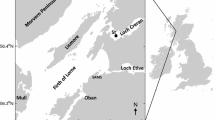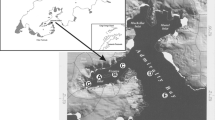Abstract
Annual primary production in 1990 in the Marsdiep amounted to about 250 g C.m−2, which is lower than during the mid 1980s, but still higher than the about 150 g C.m−2a−1 measured during the 1960s and early 1970s. The annual curve shows a clear spring peak and a broad but lower summer peak. Chloropyll-a showed a similar annual curve, the maximum of 35 mg.m−3 during the spring peak, as well as the annual average of 6 mg.m−3 were lower than during the late 1970s and the 1980s. Organic carbon values for 1990 were similar to those observed in 1978 to 1984. Turbidity (at high tide) at our sampling station did not change over the period 1973 to 1990. The high winter temperature of 1989/90 did not influence the timing of the phytoplankton spring bloom. The diatom spring peak is better related to light. With more light in spring and clearer water, the peak occurs earlier. The trend of an increase of the period of occurrence ofPhaeocystis continued.Phaeocystis colonies and single cells were present almost the year round, however, the maximum cell numbers ofPhaeocystis (80,000 ml−1) was relatively low. Newly formed colonies on spines of diatoms (Chaetoceros sp.,Bacteriastrum hyalinum) were observed in autumn. Its life-cycle remains enigmatic.Rhizosolenia indica, a warm water species, was observed for the first time in net-plankton samples, it occurred from September to December 1990.
Similar content being viewed by others
References
BAKKER, C., P.M.J. HERMAN and M. VINK, 1990. Changes in seasonal succession of phytoplankton induced by the storm-surge barrier in the Oosterschelde (S. W. Netherlands). J. Pankt. Res., 12: 947–972.
BEUKEMA, J.J., and G.C. CADÉE, 1986. Zoobenthos responses to eutrophication of the Dutch Wadden Sea. Ophelia, 26: 55–64.
BOALCH, G.T., 1984. Recent blooms in the western English Channel. ICES Special meeting on Marine Blooms, Paper A 9.
CADÉE, G.C. 1982. Tidal and seasonal variation in particulate and dissolved organic carbon in the western Dutch Wadden Sea and Marsdiep tidal inlet. Neth. J. Sea Res., 15: 228–249.
CADÉE, G.C., 1984. Has input of organic matter into the western part of the Dutch Wadden Sea increased during the last decades? Proc. 4th Intern. Wadden Sea Symp. Public. Ser. Neth. Inst. Sea Res., 10: 71–82.
CADÉE, G.C., 1986. Recurrent and changing seasonal patterns in phytoplankton of the westernmost inlet of the Dutch Wadden Sea from 1969 to 1985. Mar. Biol., 93: 281–289.
CADÉE, G.C., 1990a. Increased blooms. Nature, 346: 418.
CADÉE, G.C., 1990b. Increase inPhaeocystis blooms in the westernmost inlet of the Wadden Sea, the Marsdiep, since 1973. In: Lancelot, C., G. Billen and H. Barth, eds., Eutrophication and algal blooms in North Sea coastal zones, the Baltic and adjacent areas. E.C. Water Pollution Res. Rep., 12: 105–112.
CADÉE, G.C., 1991. Trends in Marsdiep phytoplankton. Proc. 7th Wadden Sea Symposium, Ameland. Publ. Neth. Inst. Sea Res. (in press).
CADÉE, G.C. and J. HEGEMAN, 1974. Primary production of phytoplankton in the Dutch Wadden Sea. Neth. J. Sea Res., 8: 240–259.
CADÉE, G.C. and J. HEGEMAN, 1979. Phytoplankton primary production, chlorophyll and composition in an inlet of the western Wadden Sea (Marsdiep). Neth. J. Sea Res., 13: 224–241.
CADÉE, G.C. and J. HEGEMAN, 1991. Historical phytoplankton data for the Marsdiep. Hydrobiol. Bull., 24: 111–118.
CEDERWALL, H. and R. ELMGREN, 1990. Biological effects of eutrophication in the Baltic Sea, particularly the coastal zone. Ambio, 19: 109–112.
CLEVE, P.T., 1899–1900. The plankton of the North Sea, the English Channel and the Skagerak. K. Svensk. Vet.-Akad. Handl., 32(7): 1–33; 32(8): 1–53; 34(2): 1–77.
DAVIES, A.G., 1990. Spring bloom study 1990. Informal News, EEC ProjectPhaeocystis; 4–5.
DE JONGE, V.N., 1986. Extraction of deposits in the Dutch Wadden Sea: a possible cause of increased turbidity. Report Tidal Waters Division RWS GWAO-86, 453.
DREBES, G., 1974. Marines Phytoplankton, eine Auswahl der Helgoländer Planktonalgen (Diatomeen, Peridineen). Thieme, Stuttgart.
GRAN, H.H., 1902. Das Plankton des Norwegischen Nordmeeres. Rep. Norw. Fish. Mar. Invest., 2: 1–222.
JAHNKE, J., 1989. The light and temperature dependance of growth rate and elemental composition ofPhaeocystis globosa Scherffel andP. pouchetii (Har.) Lagerh. in batch cultures. Neth. J. Sea Res., 23: 15–21.
JAHNKE, B. and M.E.M. BAUMANN, 1987. Differentiation betweenPhaeocystis pouchetii (Har.) Lagerheim andPhaeocystis globosa Scherffel. I. Colony shapes and temperature tolerances. Hydrobiol. Bull., 21: 141–147.
KAYSER, H., 1970. Experimental-ecological investigations onPhaeocystic poucheti (Haptophyceae): cultivation and waste water test. Helgoländer wiss. Meeresunters., 20: 195–212.
KINMI, 1969–1990. Maandoverzicht van het weer in Nederland. Koninkijk Nederlands Meteorologisch Instituut, De Bilt. vol. 66–87.
KORNMANN, P., 1955. Beobachtungen anPhaeocystis-Kulturen. Helgoländer wiss. Meeresunters., 5: 218–233.
LANCELOT, C., G. BILLEN, A. SOURNIA, T. WEISSE, F. COLIJN, M.J.W. VELDHUJS, A. DAVIES and P. WASSMAN, 1987.Phaeocystis blooms and nutrient enrichment in the continental coastal zones of the North Sea. Ambio, 16: 38–46.
LEEWIS, R.J., 1985. Phytoplankton off the Dutch coast. Ph.D. Thesis Univ. Nijmegen, Van Gorcum, Assen.
LORENZEN, C.J., 1967. Determination of chlorophyll and pheopigments, spectrophotometric equations. Limnol. Oceanogr., 12: 343–346.
MARCHETTI, R., 1988. Indagini sul problema dell eutrofizzazione delle acque costiere dell Emilia-Romagna. Regione Emilia Romagna, Assessorato ambiente e difesa del suolo.
MARCHETTI, R., A. PROVINI and G.F. GAGGINO, Eutrophication of inland and coastal waters in italy. Ann. New York Ac. Sci., 534: 950–958.
MARCHETTI, R., M. LACOMINI, G. TORRI and B. FOCHER, 1989. Caratterizzazione preliminare degli essudati di origine fitoplanctonica raccolti in Adriatico nell estate 1989. Acqua Aria 8: 883–887.
MENZEL, D.W., and R.F. VACCARO, 1964. The measurement of dissolved and particulate carbon in seawater. Limnol. Oceanogr., 9: 138–142.
OWENS, N.J.P., D. COOK, M. COLEBROOK, H. HUNT and P.C. REID, 1989. Long term trends in the occurrence ofPhaeocystis sp. in the north-east Atlantic. J. mar. biol. Ass. (U.K.), 69: 813–821.
PARKE, M., J.C. GREEN and I. MANTON, 1971. Observations on the fine structure of the zoids of the genusPhaeocystis (Haptophyceae). J. mar. biol. Ass. (U.K.), 51: 927–941.
POSTMA, H. and J.W. ROMMETS, 1970. Primary production in the Wadden Sea. Neth. J. Sea Res. 4: 470–493.
RADACH, G., J. BERG and E. HAGMEIER, 1990. Long-term changes of the annual cycles of meteorological, hydrographic, nutrient and phytoplankton time series at Helgoland and at LV Elbe I in the German Bight. Cont. Shelf Res., 10: 305–328.
REID, P.C., 1990. The dynamics of algal blooms in the North Sea. In: Lancelot, C., G. Billen and H. Barth. eds., Eutrophication and algal blooms in North Sea coastal zones, the Baltic and adjacent areas. E. C. Water Pollution Res. Rep. 12: 57–73.
SOURNIA, A. 1988.Phaeocystis (Prymnesiophyceae): how many species? Nova Hedwigia, 47: 211–217.
SMAYDA, T.J., 1984. Variations and long-term changes in Narragansett Bay. a phytoplankton based coastal marine marine ecosystem: relevance to field monitoring for pollution assessment. In White, H.H., ed. Concepts in marine pollution measurements, Maryland Sea Grant College. University of Maryland, College Park, p. 663–679.
SMAYDA, T.J., 1990. Novel and nuisance phytoplankton blooms in the sea: evidence for a global epidemic. In: Granéli, G., et al., eds. Toxic marine phytoplankton. Elsevier, Amsterdam, p. 29–40.
STEEMANN NIELSEN, E., 1952. The use of radioactive Carbon (C 14) for measuring organic production in the sea. J. Cons. 18: 117–140.
VAN BENNEKOM, A.J., E. KRIJGSMAN-VAN HARTINGSVELD, G.C.M. VAN DER VEER and H.F.J. VAN VOORST, 1974. The seasonal cycle of reactive silicate and suspended diatoms in the Dutch Wadden Sea. Neth. J. Sea Res., 8: 174–207.
VAN BREEMEN, P.J., 1985. Plankton van Noordzee en Zuiderzee. Ph.D. Thesis, Univ. Amsterdam. Brill, Leiden.
VAN DER HOEVEN, P.C.T., 1982. Observations of surface watertemperature and salinity, State Office of Fishery Research (RIVO): 1860–1981. Scientific Rep. Kon. Ned. Meteorol. Inst., 82: 1–118.
VAN DER VEER, H.W., W. VAN RAAPHORST and M.J.N. BERGMAN, 1989. Eutrophication of the Dutch Wadden Sea: external nutrient loadings of the Marsdiep and Vliestroom basin. Helgol. Meeresunters., 43: 501–515.
WEISSE, T. and U. SCHEFFEL-MÖSER, 1990. Progress report of the Konstanz group. Informal News, EEC ProjectPhaeocystis: 17–22.
Author information
Authors and Affiliations
Rights and permissions
About this article
Cite this article
Cadée, G.C., Hegeman, J. Phytoplankton primary production, chlorophyll and species composition, organic carbon and turbidity in the Marsdiep in 1990, compared with foregoing years. Hydrobiological Bulletin 25, 29–35 (1991). https://doi.org/10.1007/BF02259586
Issue Date:
DOI: https://doi.org/10.1007/BF02259586




